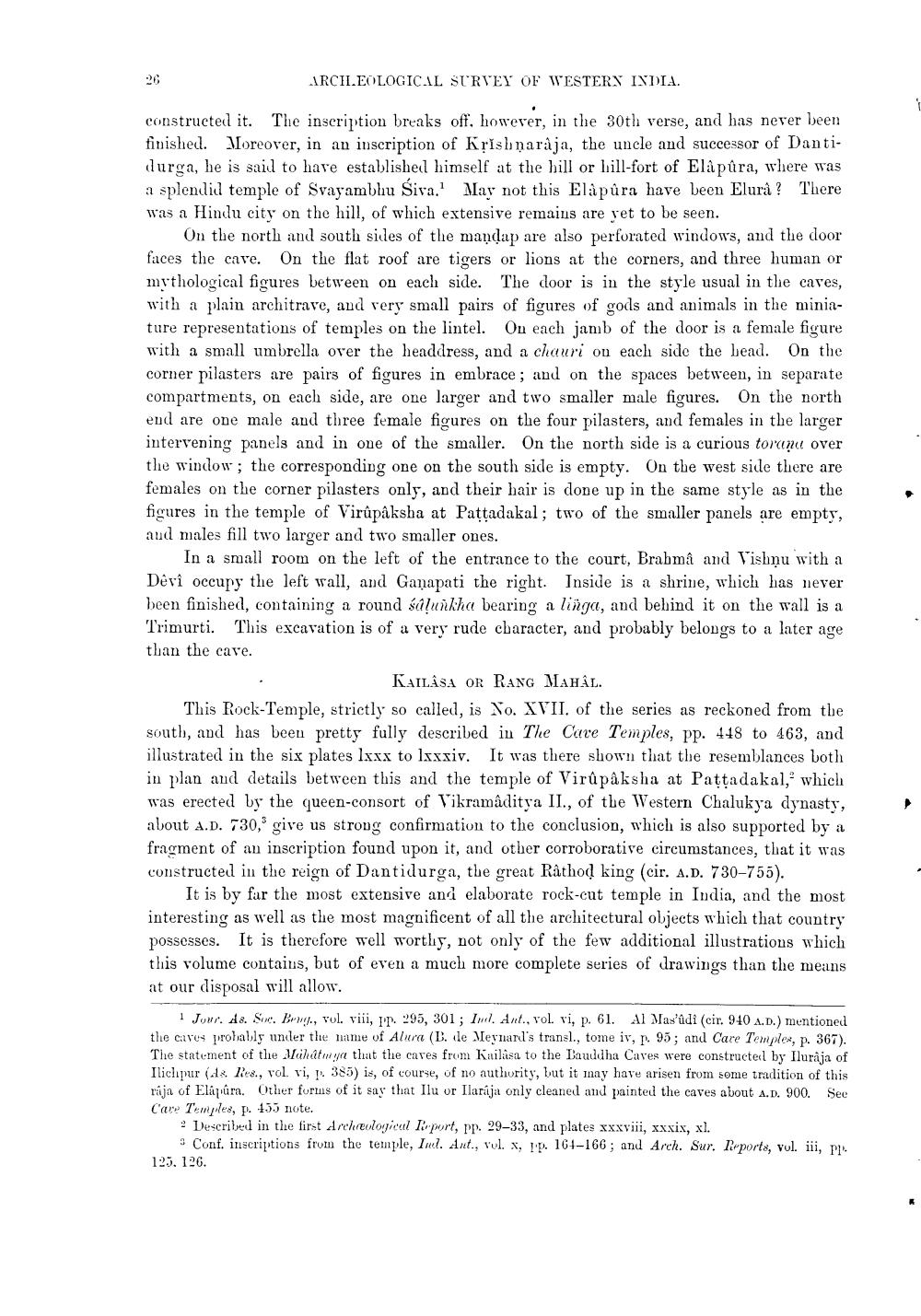________________
IRCHEOLOGICAL SURVEY OF WESTERN INDIA.
constructed it. The inscription breaks off, however, in the 30th verse, and has never been finished. Moreover, in an inscription of Krishnaraja, the uncle and successor of Dantidurga, he is said to have established himself at the bill or lill-fort of Elå půra, where was a splendid temple of Svayambhu Śiva. May not this Elå půra have been Elurå? There was a Hindu city on the hill, of which extensive remains are yet to be seen.
On the north and south sides of the mandap are also perforated windows, and the door faces the cave. On the flat roof are tigers or lions at the corners, and three human or mythological figures between on each side. The door is in the style usual in the caves, with a plain architrave, and very small pairs of figures of gods and animals in the miniature representations of temples on the lintel. On each jamb of the door is a female figure with a small umbrella over the headdress, and a chauri on each side the bead. On the corner pilasters are pairs of figures in embrace; and on the spaces between, in separate compartments, on each side, are one larger and two smaller male figures. On the north end are one male and three female figures on the four pilasters, and females in the larger intervening panels and in one of the smaller. On the north side is a curious toranu over the window; the corresponding one on the south side is empty. On the west side there are females on the corner pilasters only, and their hair is done up in the same style as in the figures in the temple of Virupaksha at Pattadakal; two of the smaller panels are empty, aud males fill two larger and two smaller ones.
In a small room on the left of the entrance to the court, Brahma and Vishnu with a Devi occupy the left wall, and Ganapati the right. Inside is a shrine, which has never been finished, containing a round salunkha bearing a linga, and behind it on the wall is a Trimurti. This excavation is of a very rude character, and probably belongs to a later age than the cave.
KAILĀSA OR RANG MAHAL. This Rock-Temple, strictly so called, is No. XVII, of the series as reckoned from the south, and has been pretty fully described in The Cave Temples, pp. 418 to 463, and illustrated in the six plates lxxx to lsxxiv. It was there shown that the resemblances both in plan and details between this and the temple of Virûpå ksha at Pattadakal," which was erected by the queen-consort of Vikramaditya II., of the Western Chalukya dynasty, about A.D. 730, give us strong confirmation to the conclusion, which is also supported by a fragment of an inscription found upon it, and other corroborative circumstances, that it was constructed in the reign of Dantidurga, the great Råthod king (cir. A.D. 730-755).
It is by far the most extensive and elaborate rock-cut temple in India, and the most interesting as well as the most magnificent of all the architectural objects which that country possesses. It is therefore well worthy, not only of the few additional illustrations which this volume contaius, but of even a much more complete series of drawings than the means at our disposal will allow.
Jowr. 48. Soc. Brw., vol. viii, Ir. 295, 301 ; Iwl. Ant., vol. vi, p. 61. Al Mas'udi (cir. 940 A.D.) mentioned the caves probably under the name of Alura (L. le Meynani's transl., tome iv, p. 95; and Care Temples, p. 367). The statement of the Jahatmya that the caves from Kailasa to the Dauddha Caves were constructed by Iluraja of Ilichpur & Res., vol. vi, 385) is, of course, of no authority, but it may have arisen from some tradition of this raja of Elipiūra. Other forms of it say that Ilu or Ilarija only cleaned and painted the caves about A.D. 900. See Car Temples, p. 157 note.
Described in the first Archeological Ivport, pr. 29-33, and plates xxxviii, xxxix, xl.
9 Conf. inscriptions from the temple, Iml. Ant., vol. x, p. 161-166 ; and Arch. Sur. Reports, vol. iii, pe 123. 126.




